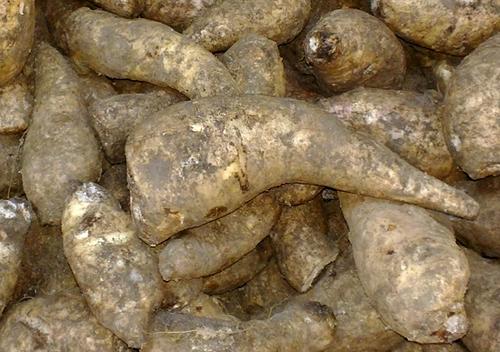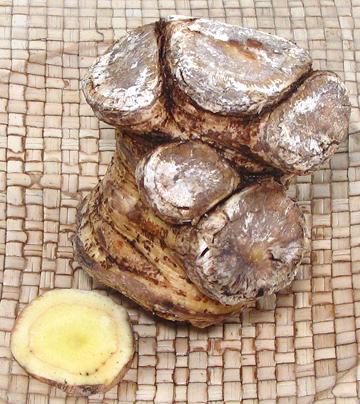 [Apio (Puerto Rico), Apio Criollo (Venezuela), Zanahoria Blanca (Ecuador),
Virraca (Peru), Mandioquinha / Batata-baroa (Brazil),
Arracacia xanthorriza]
[Apio (Puerto Rico), Apio Criollo (Venezuela), Zanahoria Blanca (Ecuador),
Virraca (Peru), Mandioquinha / Batata-baroa (Brazil),
Arracacia xanthorriza]
This parsley root, native to the Andes region of South America is a major crop in Brazil but popular all over South America and the Caribbean region. The flesh may be white, yellow or purple. It is put to uses similar to potatoes but has a more distinctive flavor and in some cultivars intense color. Leaves are used as a flavoring herb and young stems are cooked as a vegetable similarly to celery, though the stems are much thinner.
In appearance, the central root looks like a very tangled Celeriac root, and carrot-like storage roots are appended to it. These storage roots are the parts harvested for commerce and shown in the photo.
Brazil is now the center of Arracacha cultivation, and they are also grown at higher elevations in Puerto Rico, where it is popular. Arracacha is now grown in Vietnam where the starch is used to make noodles.
Subst: parsnips combined with some celery should work. Photo by Germarquezm licensed under Creative Commons Attribution-ShareAlike v3.0 Unported.More on Parsleys
 The Puerto Rican type is much different in appearance from the South
American ones in the top photo. They are sold as the main tap root,
which is like a very tangled Celeriac. This matches the description of
Apio a Puerto Rican cookbook in my posession. The blunt bottom of the
photo specimen is not cut, but is the root base.
The Puerto Rican type is much different in appearance from the South
American ones in the top photo. They are sold as the main tap root,
which is like a very tangled Celeriac. This matches the description of
Apio a Puerto Rican cookbook in my posession. The blunt bottom of the
photo specimen is not cut, but is the root base.